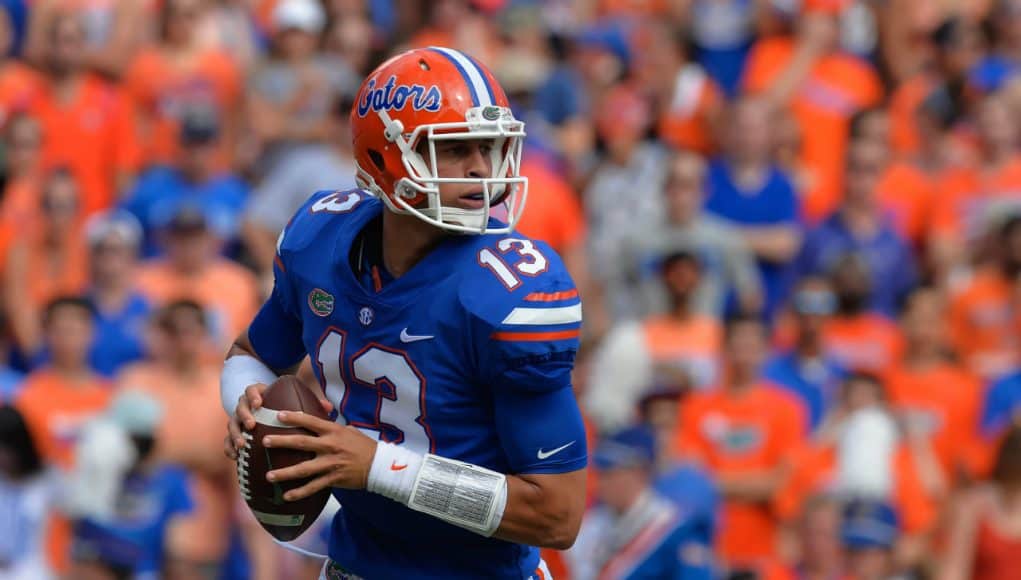Florida will not be able to beat Georgia by dinking and dunking the ball down the field. The UGA defense is one of the best in the country, while the UF offense is, well, not. The more plays a particular drive requires to move the ball down the field, the more likely it is that the Bulldogs’ superiority will win out.
For the Gators to stay in the game, they’ll have to generate some explosive plays. The best way to do that against Saban-derived defenses like what Kirby Smart and Mel Tucker run is by throwing the ball vertically up the field.
In this capacity, Tyrie Cleveland will be the most important player for the Gators in Jacksonville if he’s able to be close to 100% health. He is Florida’s only receiver able to get good separation on deeper routes consistently this year.
Cleveland also is the biggest receiver on the roster who is cleared to play. Florida lists him at 6’2″ and 205 lbs, which is noticeably bigger than most of Georgia’s cornerbacks. Big receivers who can run like he can have found some success against the Bulldogs already.
For instance, the 6’1″ Kalija Lipscomb beat the 5’10” Malcolm Parrish to set up the Vanderbilt’s only touchdown prior to garbage time.
More recently, Mizzou’s 6’3″ receiver Emmanuel Hall beat another 5’10” corner in sophomore Tyrique McGhee for a 63-yard touchdown.
In both cases, a tall receiver simply went deep along the sideline and beat a corner who was too small to be able to jump and get a hand on the pass.
In addition to targeting Cleveland, Florida might consider bringing the deep sideline fade to Josh Hammond out of mothballs. Feleipe Franks memorably completed it in the spring game and then again in his first throw against Michigan, but that play seems to have disappeared from the rotation.
Going back to Missouri’s Hall, that long touchdown where he beat McGhee was the third time the Tigers managed to get him behind the defense in the first half. Both of the other two times came as a result of errors by UGA safety J.R. Reed.
Reed is one of the surest tacklers in the SEC, but he’s not terribly experienced. He played sparingly as a true freshman at Tulsa in 2015 before sitting out 2016 as a transfer year. He’s started every game in 2017 and has been impressive at times, but he’s not completely there yet.
The first time Hall got loose behind the defense, I think Reed saw two Tiger receivers break off their routes and erroneously expected the third one to do the same. It seems like Hall lost the ball in the lights, however, bailing out Reed’s miscue.
In the second instance, Mizzou sent three receivers on vertical routes. UGA went with two deep safeties on the play. Corner Aaron Davis loses track of Hall on the receiver’s mid-route move, but he was expecting to have help deep. Reed goes to help with the middle receiver, however, and he gets turned around once he realizes that he picked the wrong guy. His help is too late, and this time Hall gets to the end zone.
In Kirby Smart’s halftime interview with Cole Cubelic, he lamented how Hall had burned his secondary. “Stay deep as the deepest, and don’t let them behind you,” was Smart’s reply to a question about Mizzou’s explosive plays.
Forcing the defense to stay deep can pay some dividends beyond hitting on the occasional long throw. Take what Notre Dame did to start their game against the Bulldogs in Week 2.
The Irish’s first play was a deep pass off of a flea flicker that Brandon Wimbush wasn’t able to complete. After a zone read run play on second down, Wimbush went deep again on the left sideline. It also wasn’t complete, but it did move the sticks with a defensive pass interference flag.
After two long throws in three plays, Georgia’s defense made sure to stay deep as the deepest on the fourth play. Notre Dame lined up in a one-back set with a tight end. Two receivers on the left side of the formation went vertical, while Cameron Smith had a right-to-left crossing route. As you can see, UGA making sure no one got behind them left the intermediate tier of the defense wide open for Smith to make an easy grab.
That kind of crossing route is absolutely in Florida’s playbook, with Hammond and Freddie Swain often being the assigned players for it. Notre Dame didn’t even have to complete a vertical pass for the intermediate cross to be open; it only had to attempt them.
Franks has been inconsistent in completing long passes. He had particular problems with it against Texas A&M without a healthy Cleveland as a target.
If Franks can find Cleveland on a deep route or two, or he can hit Hammond on that sideline fade, it will force the safeties to have to stay deep. If they can do that, things will open up for not just intermediate passes but the run, screen, and slant game as well.
The Gators won’t beat Georgia by playing it safe. They might get a big run or two from Malik Davis, but the pass game is really the place where the explosive plays are going to come from.
Now is not the time to be conservative. UF needs to use Franks’s arm and the receivers’ speed to stretch the field, or else Johnny Townsend will get far more of a workout than anyone wants to see.


